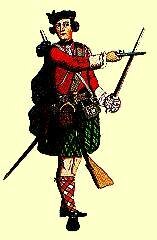
?
Our National Dress
Our National Dress is the envy of the World, the history of which has been turbulent and emotive.
Before the 1600's the standard outer garment for men was the 'Lein-chroich'(saffron tunic) - it was like a shirt with tails that came below the knees, being made from about 9 metres of pleated linen. This was replaced by the 'Feileadh Mor' known as the 'Belted plaid' In gaelic the blanket or rug is called a 'Plaide' and when it was not being used to sleep in or shelter the wearer, from the harsh Highland wilderness, it was rearranged to make the 'Feileadh Mor' or great '(Big) Kilt or covering. This garment was buckled round by a belt, the lower part being pleated with the upper loose from the shoulder. The close weave of the material it was made from made it midge proof and moderately waterproof.
IN 1700 this 'Feileadh Mor' was adapted to make easier wearing, with the lower part of the 'Feiladh' being stitched and the upper part laid aside, being known as the 'Feileadh Beag',the '(Little) Kilt'. However the 'Feileadh Mor' was still widely used until the dissarming acts of 1725 and 1746.
The modern form of the Kilt is a version of the little Kilt and uses an average of 7.3 metres of woollen cloth to be made. After 1782 the act "proscribing of Highland Dress" was repealed and the 'Little Kilt' was again worn. In the 19th century the kilt, and tartan in general, came into fashion, thanks mainly to the efforts of Sir Walter Scott and Queen Victoria, who along with her consort Prince Albert, enjoyed all things pertaining to Scotland and her National dress.
It was by retaining the Highland garb, for Scottish regiments, that enabled the men who joined the companies, to maintain their links, identity and trust with the ordinary clans people. Today each Scottish Regiment retains its own identity and stands out from the British Army.
In many parts of the world where Scottish people now reside there are gatherings(Highland Games), where people participate and watch the field events and the Scottish country and highland dancing, whilst listening to the music of the Bagpipes and the fiddle.So the Clan Societies are becoming stronger and bring a bond to the people.
We Scots are very proud that people from other Nations and nationalities enjoy wearing our Highland dress, joining in with our customs, playing in Pipe Bands and dancing. Here there are more Scots who have taken to Highland dress and are enjoying the reels and other forms of dance. At weddings it seems as though Highland Dress outstrips the usual garb with the ladies and children also getting in on the action!

?Shop History? ?Visit the Shop
Copyright Macphersons of Edinburgh 1999
Created by Anthony Cranfield & Keith Crawford 1999